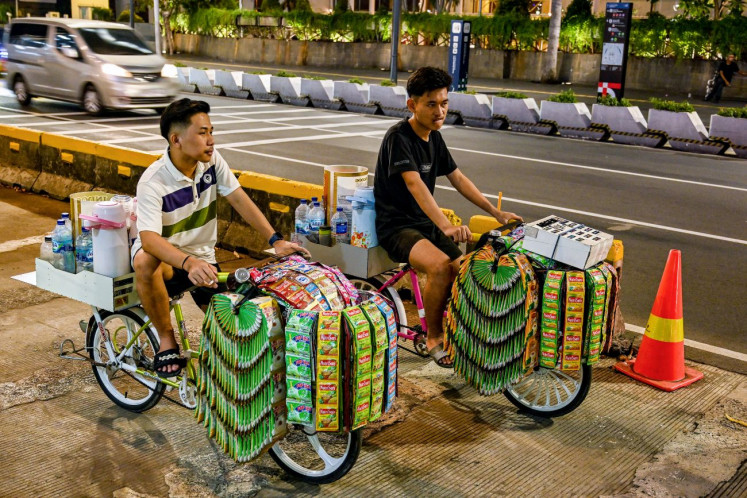Popular Reads
Top Results
Can't find what you're looking for?
View all search resultsPopular Reads
Top Results
Can't find what you're looking for?
View all search resultsHow humans and robots can co-exist in cities
Robots are taking on more tasks in the world’s cities and making life easier for residents but by doing so create more challenges for policymakers.
Change text size
Gift Premium Articles
to Anyone
Humans are steadily handing over responsibility for the day-to-day running of cities to robots.
The masters of the mundane no longer have beating hearts. Driverless cars and trains, service robots in shops, drones that deliver meals or purchases, automated pharmacists and 3D printing are just some of the more visible signs of a robot-driven metropolis.
And away from the public gaze, traffic systems, policing, waste management and healthcare are being given over to machines that can process data far more efficiently than any human.
Technological advances in robotics are driving the development of smart cities so much that it’s inspired an entire field of research called Robot-City Interaction (RCI), where the integration of robots in urban ecosystems and how they can improve quality of life is a major field of study.Human-Robot Interaction (HRI) is another rapidly evolving field of research. The Massachusetts Institute of Technology (MIT) divides HRI into four areas:
- Robots that perform routine tasks under human supervision;
- Remote control vehicles for hazardous tasks or in inaccessible environments;
- Driverless passenger vehicles – including planes, trains and automobiles;
- Human-robot social interaction – involving robots that entertain, teach, comfort and nurse children, the elderly, autistic and the disabled.
For now, at least, all robots are controlled by humans, either steered by continuous manual movement or intermittently monitored and reprogrammed by human supervisors. But what happens in the future with HRI is open to conjecture.
HRI is applied in almost all robot tasks mentioned above and marks the ongoing disruptive era of the fifth industrial revolution, where human needs for customisation and more involvement in machines’ evolution.
The rise of robots is forcing policymakers worldwide to invest in supporting the development of urban infrastructures that integrate robotic technologies.
Sydney Metro is revolutionising how residents in Australia’s largest city travel with fast, reliable driverless metro services. The project boosts public spaces with vibrant transport precincts, combining urban renewal and better transport connections.Sydney joins 42 cities around the world – including Singapore, Vancouver and London – that run 64 fully-automated metro services. More than half of those are in Asia – China alone will have 32 fully-automated metro lines across 16 cities by the end of 2022.
However, experts say that automation cannot be successful without human perspectives.
The digital disruption associated with the fourth industrial revolution challenged established ways of doing business, social interaction, and how humans think, according to an analysis by Kai Riemer, a professor of information technology and organisation at the University of Sydney. He says it is essential to be strong on the human side of the HRI, understanding how technologies change the world rather than just dabbling in the technology itself.
In most developing countries, HRI is still in its infancy. In Bandung, Indonesia, which launched its smart city in 2015, officials tried to implement it via Bandung Command Centre, which included app-based city management and development control systems; integrated smart government and smart society; and CCTV-based city monitoring.
Bandung Smart City still faces many challenges and opportunities. Information and communication technology (ICT) infrastructure must support citizens’ participation as a sustainable smart city is based on humans.
And in the disruptive era of IR 5.0, the extent to which stakeholders are likely to adopt HRI robots to improve cities’ services remains a challenge.In the era of disruptive technologies, business leaders and policymakers should look forward, identify the technologies that could affect them and determine how to shape markets and policies to serve their interests. Business leaders should define when, how, and whether to take advantage of new technologies and be prepared to switch. And policymakers may need to update their approaches to ease the adoption of new technologies while managing the attendant risks.
It is important to have adaptive regulations that adjust to rapid change. Good policy should be technically correct, politically stable, and organisationally implementable. Research relating to the value of humans is still one of the main challenges of HRI. The question is: If a robot can more efficiently do a job, should that job always be automated?
The big question and challenge for policymakers is how they consider the potential consequences of increasing the gap between skilled and unskilled workers, whose jobs are most likely to be affected by automation.
Policymakers also need to consider what jobs will emerge and whether the workforce will be able to transition.
---
The writer is a researcher at the City Future Research Centre, School of Built Environment, Faculty of Arts, Design, and Architecture, UNSW, Sydney, Australia. His research is focused on smart cities and sustainability.
Originally published under Creative Commons by 360info™.











